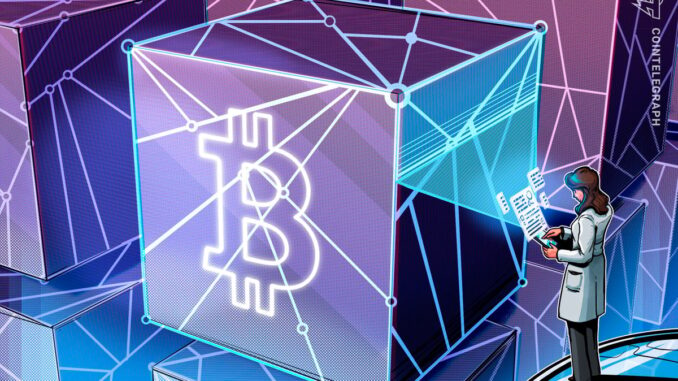
[ad_1]
A Bitcoin (BTC) block that took over an hour to mine made headlines earlier in November. This is despite Bitcoin’s core protocol being written to aim to mine a block every 10 minutes.
Block 815,690 is the latest outlier to generate press speculation. This block took one hour and nine minutes to mine on Nov. 7. Public interest in an hour-plus confirmation time is not a singular event. Roughly once or twice a year, a media outlet picks up on a long block validation event and decides to run with the story.
On Oct. 17, 2022, a prominent crypto news site reported on a block that took one hour and 25 minutes to mine, which spurred a flurry of similar reports. As the story spread widely on social media, some fans reveled in the relative speed of their favored centralized altcoin.
The report eventually caught the attention of Lighting Network founder Tadge Dryja, who was decidedly unimpressed.
As Dryja pointed out on X (formerly Twitter): “A time between blocks of 85 minutes happens every 34 days or so (assuming no difficulty changes, etc).”
Dryja’s point was clear: A single long block alone is no cause for alarm. Given the regularity of longer blocks, Dryja questioned whether the article would be a new monthly feature for the publication.
Probability is tricky
While almost everyone who knows about Bitcoin understands that the coin’s proof-of-work consensus mechanism is a puzzle of computational guesswork, the math that underpins this knowledge is infinitely harder to understand.
The probability of an hour-long block occurring is relatively low, and it is also higher than humans intuitively expect. Most of the time, longer blocks go unnoticed, at least by the press.
This might help to explain why longer blocks become a talking point whenever someone stumbles across them.
Recent: Bitcoin’s many deaths: Is crypto market past ‘point of no return?’
In February 2021, a crypto community member on X, Bitcoin Jack, noticed that one hour and 46 minutes passed between blocks 670,637 and 670,638. That’s just one block confirmed where 10 or 11 would typically be expected.
Jack tagged cypherpunk and Bitcoin advocate Jameson Lopp to ask how common such occurrences were. Lopp confirmed that 190 blocks had taken 106 minutes or more to mine in the previous 12 years. It’s worth remembering, however, that in its earliest years, Bitcoin blocks more regularly took longer to mine, which skews the figures slightly.

Very unusual blocks
Hour-long plus blocks are more commonplace than most Bitcoiners might guess, but some blocks are more extreme.
One such block came immediately after Satoshi Nakamoto mined the Genesis Block on Jan. 3, 2009. That block is probably the most famous in Bitcoin’s history. Learning its inscription “03/Jan/2009 Chancellor on brink of second bailout for banks” is practically a Bitcoin right of passage.
The next block in Bitcoin’s blockchain is far less known but no less fascinating. The second block wasn’t mined until six days later, on Jan. 9. Bitcoin fans have speculated on its meaning — or whether it means anything at all.
Some theorists even claim the six-day waiting period is a Biblical allegory — let there be Bitcoin. Whatever the truth, the time interval between these two blocks remains the longest in Bitcoin’s history.
On the flip side, there are blocks with roughly the same timestamp as their predecessors, while others have timestamps that predate their forebearers. Of course, timestamps are not always accurate, especially since human hands can adjust the clocks on Bitcoin miners.
According to timestamp codes, Bitcoin block 156,113 was mined On Dec. 5 at 8:16 am. Those same codes reveal that Bitcoin block 156,114 was mined on Dec. 5 at 6:17 am — one hour 59 minutes earlier.
That would be a neat trick if accurate, but the likely cause of these time-related shenanigans is a miscalibrated clock on the mining equipment.
Bitcoin: A self-righting machine
Understanding block times is tricky because it relies on probability, but other factors complicate matters further. For one thing, the number of miners on the network is in constant flux.
To ensure the 10-minute average is maintained, Bitcoin mining difficulty can be adjusted every 2,016 blocks. If the average is too high, then difficulty is lowered; if it is too low, difficulty is increased.
When Lopp investigated Bitcoin block times in 2021, he concluded that “By analyzing the actual distribution of block times we can see that the math behind the targeted block time of 10 minutes has held up quite well over the past 12 years and the few edge case aberrations can be easily explained.”

In the last five years, for every month barring one, the mean block interval on the Bitcoin blockchain landed within a minute of its target. In three out of the last five years, the yearly average landed within 10 seconds of the 10-minute target.
By these metrics, the Bitcoin network is becoming more stable and reliable over time.
The single “edge case” in this period occurred in June 2021. At the tail end of May 2021, China banned Bitcoin mining. The result was a drastic fall in the network’s computational power mining blocks. In June, the Bitcoin mean block time hit 732 seconds — over two minutes longer than the target period — as the network dealt with the knock-on effects.
Magazine: Lawmakers’ fear and doubt drives proposed crypto regulations in US
It took until Dec. 2021 for the network hash rate to recover to previous levels, but thanks to the difficulty adjustment, the 10-minute window was reestablished in July.
In Nov. 2018, during the depths of crypto winter, average block times rose to 670 seconds. This occurred as miners switched off older, less efficient mining equipment that was no longer profitable in the face of reduced Bitcoin prices.
In both of these instances, the network self-corrected the following month. As far as longer blocks are concerned, the Bitcoin network is a battle-tested self-righting machine.
[ad_2]
Source link



